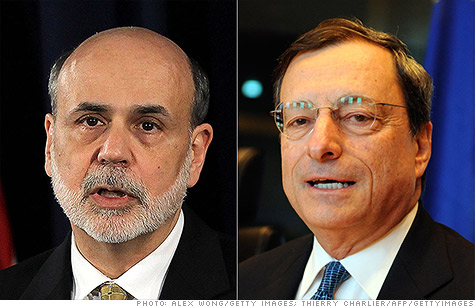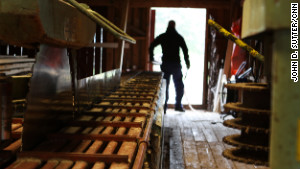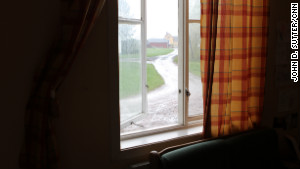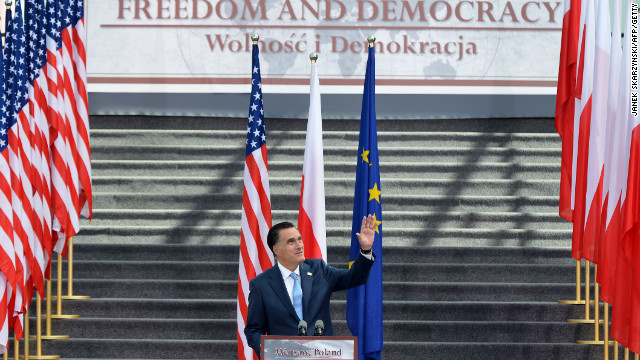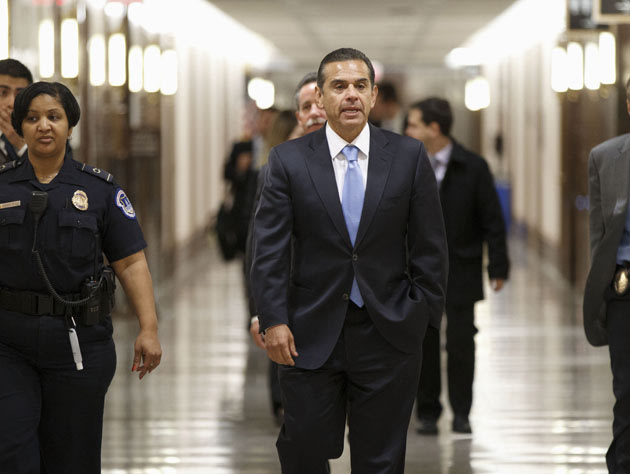STORY HIGHLIGHTS
- Bastoy prison is on an island in southern Norway
- There are no fences or armed guards; inmates hold the keys to locks
- Inmates have access to beaches, horses and a sauna
- Norway's unique justice system has been in the spotlight since a terror attack last summer
-- Jan Petter Vala, who is serving a prison sentence for murder, has hands the size of dinner plates and shoulders like those of an ox. In an alcoholic rage, he used his brutish strength to strangle his girlfriend to death a few years ago.
On a recent Thursday, however, at this summer-camp-like island prison in southern Norway, where convicts hold keys to their rooms and there are no armed guards or fences, Vala used those same enormous hands to help bring life into the world.
The 42-year-old murderer stood watch while an oversize cow gave birth to a wobbly, long-legged, brown-and-white calf. He cried as the baby was born, he said, and wiped slime off of the newborn's face so she could gulp her first breath.
Afterward, Vala called his own mother to share the good news.
"I told my family that I'm going to be a dad," he said, beaming with pride.
This is exactly the type of dramatic turnabout -- enraged killer to gentle-giant midwife -- that corrections officials in Norway hope to create with this controversial, one-of-a-kind prison, arguably the cushiest the world has to offer.
Founded in 1982, Bastoy Prison is located on a lush, 1-square-mile island of pine trees and rocky coasts, with views of the ocean that are postcard-worthy. It feels more like a resort than jail, and prisoners here enjoy freedoms that would be unthinkable elsewhere.
It's the holiday version of Alcatraz.
Overheard on CNN.com: What's prison for?
There's a beach where prisoners sunbathe in the summer, plenty of good fishing spots, a sauna and tennis courts. Horses roam gravel roads. Some of the 115 prisoners here -- all men and serving time for murder, rape and trafficking heroin, among other crimes -- stay in wooden cottages, painted cheery red. They come and go as they please. Others live in "The Big House," a white mansion on a hill that, on the inside, looks like a college dorm. A chicken lives in the basement, a guard said, and provides eggs for the inmates.
When you ask the cook what's for dinner, he offers up menu choices like "fish balls with white sauce, with shrimps" and "everything from chicken con carne to salmon."
Plenty of people would pay to vacation in a place like this.
On first read, all of that probably sounds infuriating. Shouldn't these men be punished? Why do they get access to all these comforts while others live in poverty?
But if the goal of prison is to change people, Bastoy seems to work.
"If we have created a holiday camp for criminals here, so what?" asked Arne Kvernvik Nilsen, the prison's governor and a former minister and psychologist. He added, "We should reduce the risk of reoffending, because if we don't, what's the point of punishment, except for leaning toward the primitive side of humanity?"
Take a quick look at the numbers: Only 20% of prisoners who come through Norway's prisons reoffend within two years of being released, according to a 2010 report commissioned by the governments of several Nordic countries.
At Bastoy, that figure is even lower, officials say: about 16%.
Compare that with the three-year re-offense rate for state prisons in the U.S.: 43%, according to a 2011 report from the Pew Center on the States, a nonpartisan research group. Older government reports put that number even higher, at more than five in 10.
Ryan King, a research director at Pew and an author of the group's recent report, said it's difficult to compare recidivism rates from state to state, much less from country to country. Instead of focusing on the numbers, he said, one should focus on what a country is or isn't doing to tackle re-offense rates.
Still, Bastoy remains controversial even in academia. Irvin Waller, president of the International Organization for Victim Assistance and a professor at the University of Ottawa, said in an e-mail that the relative niceness of a prison has no effect on whether people commit crimes when they're released. "The key is not that much what happens in prison but what happens when the men are released," he said.
Jan Petter Vala is serving part of a 10-year murder sentence on a posh island in southern Norway.
But officials here maintain that their methods do make a difference, and they follow it up with post-release programs. The aim of Bastoy is not to punish or seek revenge, Nilsen said. The only punishment is to take away the prisoner's right to be a free member of society.
Even at a time when Anders Behring Breivik is on trial in Norway for killing 77 people in a terror attack last year -- and the remote possibility he could end up at Bastoy or a similar prison some day -- Nilsen and others stand up for this brand of justice.
Life at Bastoy
To understand Norway's pleasant-prison philosophy, first you have to get a sense of how life at a cushy, low-security prison like Bastoy actually plays out.
There are few rules here. Prisoners can have TVs in their rooms, provided they bring them from "outside" when they're sentenced. They wear whatever clothes they want: jeans, T-shirts. One man had a sweater with pink-and-gray horizontal stripes, but that's as close as it got to the jailbird look. Even guards aren't dressed in uniform, which makes conducting interviews tricky. It's impossible to tell an officer from a drug trafficker.
A common opening question: "So, do you live here?"
Everyone at Bastoy has a job, and prisoners must report to work from 8:30 a.m. to 3:30 p.m. weekdays. Some people garden; others farm. Some chop down trees and slice them into firewood (It's hard not to think about the wood chipper scene in "Fargo" when you see inmates filleting tree trunks with an enormous circular saw). Others tend to a team of horses, which are used to cart wood and supplies from one part of the island to another. Everyone moves about freely during these tasks. Guards are sometimes present, sometimes not. No one wears shackles or electronic monitoring bracelets.
The idea is for prison to function like a small, self-sustaining village.
For their work, inmates are paid. They get a stipend of 59 Norwegian kroner per day, about $10. They can save that money or spend it on odds and ends in a local shop. Additionally, they get a monthly stipend of about $125 for their food. Kitchen workers -- that's another inmate job -- serve Bastoy residents dinner each day. For breakfast and lunch, inmates use their stipend to make purchases in the local shop and then cook for themselves at home. Many live in small houses that have full kitchens. Others have access to shared cooking space.
The goal, Nilsen said, is to create an environment where people can build self-esteem and reform their lives. "They look at themselves in the mirror, and they think, 'I am s***. I don't care. I am nothing,' " he said. This prison, he says, gives them a chance to see they have worth, "to discover, 'I'm not such a bad guy.' "
In locked-down prisons, inmates are treated "like animals or robots," he said, moving from one planned station to the next, with no choice in the matter. Here, inmates are forced to make choices -- to learn how to be better people.
Prisoners, of course, appreciate this approach.
Kjell Amundsen, a 70-year-old who said he is in jail for a white-collar financial crime, was terrified when he rode the 15-minute ferry from the mainland out to Bastoy.
On a recent afternoon, he was sweeping up in a plant nursery while John Lennon's "Imagine" played on the radio. "I think it's marvelous to be in a prison this way," he said.
He plans to keep up the task after his sentence ends. "I'm living in a flat (when I get out), but I am convinced I should have a little garden," he said.
Bastoy Prison functions like a small village. Everyone has a job, including chopping firewood.
Some prisoners get schooling in a yellow Bavarian-style building near the center of the island. On a recent afternoon, three young men were learning to use computer programs to create 3-D models of cars. All expressed interest in doing this sort of work after their prison terms end.
Tom Remi Berg, a 22-year-old who said he is in prison for the third time after getting into a bar fight and beating a man nearly to death, said he is finally learning his lesson at Bastoy.
He works in the kitchen and is seeking training to become a chef when he's released. He also plays in the prison blues band -- Guilty as Hell -- and lives with his bandmates.
"It's good to have a prison like this," he said. "You can learn to start a new page again."
If escaped, please call
The prisoners are required to check in several times a day so guards can make sure they're still on the island. Nothing but 1½ miles of seawater stops them from leaving; they'd only have to steal one of the prison's boats to cross it, several inmates said.
An escape would be relatively easy.
Prisoners have tried to escape in the past. One swam halfway across the channel and became stranded on a buoy and screamed for rescuers to help, prison officials said. Another made it across the channel by stealing a boat but was caught on the other side.
Many, however, don't want to leave. If they tried and failed, they would be forced to go to a higher-security prison and could have their sentences extended.
When inmates come to his island jail, Nilsen, the governor, gives them a little talk.
Among the wisdom he imparts is this: If you should escape and make it across the water to the free shore, find a phone and call so I know you're OK and "so we don't have to send the coast guard looking for you."
This kind of trust may seem shocking or naïve from the outside, but it's the entire basis for Bastoy's existence. Overnight, only three or four guards (the prison employs 71 administrative staff, including the guards) stay on the island with this group of people who have been convicted of serious crimes. If guards carried weapons (which they don't) it might encourage inmates to take up arms, too, he said.
Further complicating the security situation, some inmates, toward the end of their terms, are allowed to leave the island on a daily ferry to work or attend classes on the mainland.
They're expected to come back on their own free will.
Some prisoners live in dorm-like rooms; they aren't locked in, and guards are not armed.
Inmates are screened to make sure they're mentally stable and unlikely to plot an escape before they come to Bastoy. The vast majority -- 97%, according to Nilsen -- have served part of their sentences at higher-security jails in Norway. In the four years Nilsen has been heading up the prison, there have been no "serious" incidents of violence, he said.
By the time they get to Bastoy, inmates view the island as a relief.
'It's still prison'
There's a question inmates here get asked frequently: When your sentence is up, will you want to leave?
The answer, despite the nice conditions, is always an emphatic yes.
"It's still prison," said Luke, 23. He didn't want his full name used for fear future employers would see it. "In your mind, you are locked (up)."
The simple fact of being taken away from family members is enough to stop Benny, 40, from wanting to offend again. The refugee from Kosovo said he was convicted on drug charges after he was found with 13 pounds of heroin. He didn't want his full name used because he doesn't want to embarrass his family or jeopardize his chance of finding a job after he's released.
Before coming to Bastoy, he sat in a higher-security prison while one of his children was born.
"It doesn't matter how long the sentences get. The sentence doesn't matter," Benny said. "When you take freedom from people, that's what's scary."
There are only 3,600 people in prison in this country, compared with 2.3 million in the United States, according to the Bureau of Justice Statistics. Relative to population, the U.S. has about 10 times as many inmates as Norway.
More than 89% of Norway's jail sentences are less than a year, officials said. In U.S. federal prisons, longer sentences are much more common, with fewer than 2% serving a year or less, according to the Federal Bureau of Prisons.
Some researchers support Norway's efforts to lighten sentences.
Think of prison like parenting and it starts to make sense, said Mark A.R. Kleiman, a professor of public policy at UCLA and author of "When Brute Force Fails."
"Every parent knows this. What if you tried to discipline your kid by saying, 'If you don't clean your room, there's a 10% chance I'll kick you out of the house and never see you again'?" he said, referencing the fact that many crimes in America go unpunished, but the justice system issues harsh sentences when offenders are caught. Grounding the child immediately, a softer sentence, would work better, even though the punishment is less severe, he said.
"We have a criminal justice system (in the United States) that, if it were a parent, we would say it's abusive and neglectful."
Kleiman said victims do have a right to see offenders punished. But in Norway, a country with one of the highest standards of living in the world, staying on a resort-like island with horses might feel like punishment to many people, he said.
Research also suggests that programs like Bastoy that train inmates for their transition back into the free world -- with education, counseling and such -- do help prisoners adjust.
"There is overwhelming evidence that rehabilitation works much better than deterrence as a means of reducing re-offending," said Gerhard Ploeg, a senior adviser at the Ministry of Justice, which oversees Norway's corrections system.
"It's all in the name of reintegration," he added. "You won't be suddenly one day standing on the street with a plastic bag of things you had when you came in."
Mass shooting challenges system
Inmates at Bastoy have plenty of time for activities, including going to the gym and the beach.
Norway's unusual prison policies have been pushed into the international spotlight after a bombing and shooting spree last year in which 77 people were killed, including children.
There's a chance -- although minimal -- that Anders Behring Breivik, who confessed to those crimes, could end up in Bastoy, one of Norway's "open prisons," Nilsen said.
Norwegians value respecting killer's human rights
It's more likely Breivik will be sent to one of Norway's many high-security "closed" prisons, which look much more like their U.S. counterparts.
He also could be set free some day. Norway has a maximum jail sentence of 21 years, which can be extended only when an inmate is deemed to be a real and imminent threat to society. The country expects nearly every prisoner to be returned to society, which influences its efforts to create jail environments that reduce re-offense rates.
Lawyer: Norwegian killer vows not to appeal guilty verdict if found sane
"The question we must ask is, 'What kind of person do I want as my neighbor?' " Ploeg said. "How do we want people to come out of prison? If your neighbor were to come out of prison, what would you want him to be like?"
Still, it's likely Breivik's sentence will be extended to the point that he will spend his life in a high-security prison, he said. Or he could go into life-long psychiatric care.
Breivik's case challenges a system that hopes to fix everyone.
The case has unearthed levels of anger that are uncharacteristic of Norway, which prides itself as a home for conflict mediation and human rights, a place that hosts the Nobel Peace Prize ceremony and has one of the best standards of living in the world.
Last week, a man lit himself on fire outside the Oslo courthouse where Breivik's trial is taking place. His motives were unclear, police said.
"(Breivik) doesn't deserve to go to prison," said Camilla Bjerke, 27, who tends bar in Horten, the town on the other side of the water from Bastoy. "He deserves to be hanged outside the courthouse. ... He's just going to go into prison and watch TV and download movies."
Then there's this sentiment: If Breivik were ever released into the public, someone would kill him, several Norwegians said. Inmates at Bastoy echoed those sentiments, saying he would have to be quarantined or he wouldn't be safe on the island.
Others are trying to fight that anger.
Bjorn Ihler, a 20-year-old who narrowly escaped Breivik's shooting spree by diving into the ocean with two children while bullets flew at them, said, "it's very important that we don't let this terrorist change the way we are and the way things work."
"The prison system in Norway is based around the principle of getting criminals back into society, really, and away from their criminal life -- and to get them normal jobs and stuff like that," he said.
He doesn't know how he would feel if Breivik were to be released, but he would like the system to function as usual. "So prisons must be very much focused on getting people to a place where they are able to live normal, non-criminal lives. And that's the best way of preserving society from crime, I think."
Looking to the future
All of these efforts aim to help a person like Vala, the gentle giant who strangled his girlfriend, to get ready for release back into society at the end of his 10-year sentence.
After he helped a toddling calf come into the world, Vala said, he leaned on a rail next to the cow's pen and thought about his life and the murder that landed him here. The symbolism that he had used his hands to end one life and help begin another was not lost on him. "I stayed for six hours," he said. "It was very beautiful."
The night he killed his girlfriend, Vala says, he blacked out and then came to with his hands around her neck, after she was dead.
"We never fight," he said. "We never do. So I don't know what happened."
He felt helpless and out of control when he came to.
But now he's trying to pull it together. He decided to quit drinking for good. And when he's working with animals, he said, feels a new calm wash over him.
It's a change the prison guards have noted, too. Sigurd Vedvik said he met Vala while he was serving out the earlier part of his sentence in a high-security prison. Vedvik was screening him for entry into Bastoy. Vala barely could communicate. He seemed broken.
"When he first came here, he was very afraid of many people," said Vedvik, who sees himself as more of a teacher or social worker than a person who enforces security.
Now, Vala is making friends. Talking more. Taking responsibility for the cattle he's tasked with caring for. He strokes the cows' necks so gently, it seems as if he's worried they will shatter.
When Vala leaves Bastoy, he plans to go into the construction business and hopes to find some way to spend time on a farm.
"I'm trying to think to my future."
That's something he couldn't do after the murder.
And it took a posh prison -- one with cattle and horses -- to get him into that state of mind.




